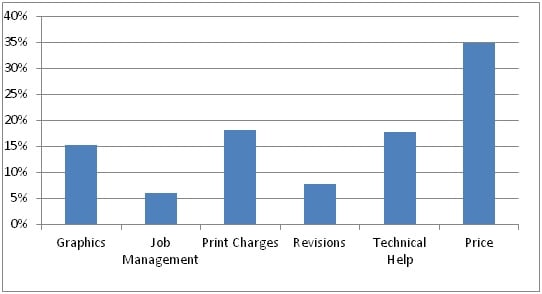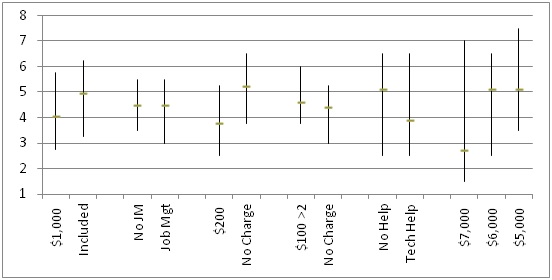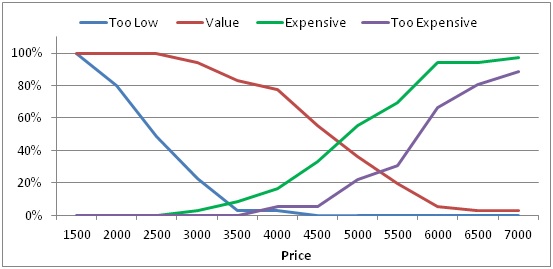 Market and competitive pricing in the B2B sector is often a challenging area for many market researchers to tackle. Actual pricing information is difficult, if not impossible, to discuss using traditional interview techniques, as this information is considered highly proprietary. Often, pricing is not a straightforward matter as it may incorporate early payment discounts, freight, volume discounts, change orders, interest, or other finance charges and many other variants.
Market and competitive pricing in the B2B sector is often a challenging area for many market researchers to tackle. Actual pricing information is difficult, if not impossible, to discuss using traditional interview techniques, as this information is considered highly proprietary. Often, pricing is not a straightforward matter as it may incorporate early payment discounts, freight, volume discounts, change orders, interest, or other finance charges and many other variants.
Some markets publish price sheets for certain products, but suppliers often discount from the published price based on volume, proprietary agreements, quality assessments, and other criteria. Or, in many cases, a competitive situation necessitates more aggressive pricing, stressing margins and negatively affecting overall profitability.
For many companies, these dynamics create a void in gathering accurate competitive pricing information. However, without this critical information, companies often decide on pricing based on internal cost and average hurdle rates. They are operating in a vacuum, not knowing:
- If they are delivering enough value to offset price
- If they are over-delivering based on the current pricing
- The attributes that are truly driving the value
- The optimal price for what is actually being delivered
There are some proven research methodologies that can deliver answers to questions like these, providing the information and insight necessary to develop an actionable pricing strategy.
Conjoint Analysis
Conjoint analysis is an advanced market research technique that provides insight into the value contribution of specific levels of selected attributes. Understanding precisely how customers value different elements of the product and service mix provides critical insight that can be used to:
- Identify the products that offer the highest and lowest value, even if they do not actually exist in the marketplace
- Direct product development efforts in delivering the best balance of features for prices the customer is willing to pay
- Develop different products for different segments aimed at maximizing the value to the customers in each respective segment
- Understand the value of competitive products (already in the marketplace) and what combination of attributes and features will provide superior value — and theoretically steal share
- Develop segments based on value perceptions
- Other analysis and insight
Figure 1 — Relative Importance

Figure 1 shows the relative importance of each attribute in a conjoint analysis. In this case, the attributes included the six listed across the bottom of the chart. Price is the most important since the price attribute held the greatest potential contribution to value. On the other hand, job management and revisions held the lowest potential value contribution and so were the least important attributes.
Figure 2 — Value Contribution

Figure 2 documents the value contribution of each level of each attribute. If we look at the first attribute — graphics — as an example, we can see that including graphics in the overall product results in an average value of 5 with a range from 3.3 up to 6.2. Charging $1,000 for graphics results in an average value of just over 4 with a range from 2.8 to 5.8.
Looking more broadly, the conjoint analysis suggests that by including graphics and not charging for print changes creates enough value to offset the jump in price from $6,000 to $7,000. So, offering a product that has these two elements at $7,000 would provide the customer the same value as a product without either element priced at $6,000.
Since conjoint analysis is valid at the individual level, results can be aggregated to form segment and market profiles that can be used to estimate market share under various circumstances and to test response to new product concepts.
Van Westendorp Price Sensitivity Analysis
A second powerful pricing tool is van Westendorp Price Sensitivity Analysis (PSA). Van West, as it is sometimes abbreviated, determines a range of acceptable prices and an optimal price point based on an analysis of price/value ratings. The analysis is based on responses to four questions:
- At what price do you think this job would be a good value?
- At what price do you think this job is expensive, but still worth considering?
- At what price do you think this job is so expensive you would not consider buying it?
- At what price do you think this job is priced so low that you would think the quality couldn’t be very good?
Plotting response profiles to these questions provides high/low price thresholds as well as the price point considered optimal. Highlighted in Figure 3 below is the intersection of line graphs of responses to each of these four questions. The common area — bounded by each of four points of intersection — will form a diamond shape profiling target price points. The four price points are:
- PMC: Point of Marginal Cheapness
- OPP: Optimal Price Point
- IPP: Indifference Price Point
- PME: Point of Marginal Expensiveness
Different users interpret the chart differently. However, it is generally agreed that either the OPP or IPP (or something in between the two) represent the ideal price point.
In this example, the optimal price point for the described product and service is $3,750, while the acceptable price range of the same product and service is between $3,300 and $5,300.
Figure 3 — van Westendorp Pricing Analysis

Developing a Pricing Strategy
Both of these analytic techniques provide valuable and actionable insight into pricing and value. Combining these techniques with a number of targeted, qualitative in-depth interviews will provide an accurate and thorough understanding of pricing and the supporting market dynamics.
These tools can form the foundation of an actionable and sustainable pricing strategy to manage and grow market share and profitability without the inherent risk of arbitrary pricing decisions.
To learn more about using market research to make strategic business decisions, check out our free ebook.
Editor's Note
This post was written by Priority Metrics Group (PMG), a MarketResearch.com partner in custom research.
About PMG
Priority Metrics Group (PMG) is a professional marketing consulting firm based in Spartanburg, South Carolina. PMG provides customized research, analysis, and consultation services designed to generate profitable growth for clients. They work with leading organizations in a variety of manufacturing and service industries. They are experts at gathering and processing market information, analyzing data, and translating information into actionable growth initiatives.


